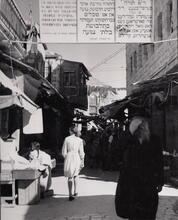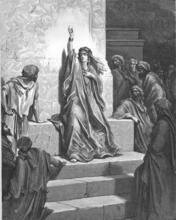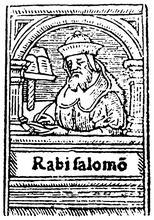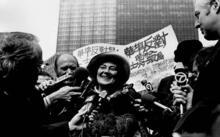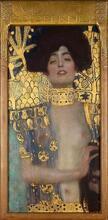Esther: Midrash and Aggadah
Queen Esther is an orphan raised by her uncle Mordecai and is eventually married to King Ahasuerus. But she does not reveal her Jewish heritage to the king and learns of a plan to kill all Jews by the king’s advisor, Haman. She recognizes that she needs to personally plead the king to save her people but knows this act is a grave transgression. She she fasts for three days, she goes to the king, enduring many obstacles while traveling through the palace but protected by angels. Her bravery earns her a spot among the seven women prophets, and she is remembered as the one responsible for the deliverance of Israel.
Queen Esther, the central character in the Biblical book named after her, is extensively and sympathetically portrayed in the Rabbinic sources. In their commentary on the Book of Esther, the Rabbis expand upon and add details to the Biblical narrative, relating to her lineage and history and to her relations with the other characters: Ahasuerus, Mordecai, and Haman.
Esther’s Origins and Her Adoption by Mordecai
The Bible depicts Esther as an orphan who was raised in the house of her uncle Mordecai (Esth. 2:7). The A type of non-halakhic literary activitiy of the Rabbis for interpreting non-legal material according to special principles of interpretation (hermeneutical rules).Midrash adds that Esther’s father died during her mother’s pregnancy, and the latter died during childbirth (Esth. Rabbah 6:5; BT Lit. "scroll." Designation of the five scrolls of the Bible (Ruth, Song of Songs, Lamentations, Ecclesiastes, Esther). The Scroll of Esther is read on Purim from a parchment scroll.Megillah13a). As a result of her mother’s death, Mordecai had to care for Esther’s nursing. According to one tradition, he could not find a wet nurse and he himself miraculously had milk and nursed her (Gen. Rabbah 30:8). Another tradition has Mordecai’s wife nursing the infant (Midrash Tehilim, on Ps. 22:23).
The Babylonian tradition maintains that Esther was Mordecai’s wife. Esth. 2:7 states: “Mordecai adopted her as his own daughter [literally: took her le-vat],” which the midrash understands as: Mordecai took her le-bayit, that is, as a wife (BT Megillah loc. cit.). This exegesis casts the Biblical narrative in a different light. Esther was taken to the royal harem despite her being married, which further aggravated her sorry condition. This also leads to a different understanding of Mordecai’s involvement, as he walks about in the royal courtyard out of concern for his wife.
Mordecai is mentioned in Esth. 2:5 as being a Benjaminite, from which the Rabbis assumed that Esther also came from this tribe. In reference to her lineage, the Rabbis state that she continued the way of the members of her tribe: Rachel, Benjamin, and Saul (Gen. Rabbah 71:35; see below: “Esther Does Not Reveal Her Origins”). In Jacob’s blessing to his sons, he blesses Benjamin (Gen. 49:27): “Benjamin is a ravenous wolf; in the morning he consumes the foe, and in the evening he divides the spoil,” which the Rabbis applied to Mordecai and Esther. Just as a wolf seizes its spoils, so did Esther seize the throne; similarly, Mordecai and Esther divided Haman’s spoils among them (Gen. Rabbah [ed. Theodor-Albeck], MS. Vatican, para. 100).
Hadassah—That Is, Esther
The Book of Esther (2:7) relates that Esther had two names: “He was foster father to Hadassah—that is, Esther.” The Rabbis take two interpretive directions as regards these names. According to one, Hadassah, which appears first in the verse, was Esther’s real name, and the reason why she was called Esther requires clarification. According to the second direction, Esther was her real name, and she is so named throughout the Book of Esther; accordingly, the name Hadassah needs further explanation.
According to the view that Esther was Hadassah’s second name, the Rabbis explain that she was given this name because she concealed (histirah) her origins. In another exposition, she was given this name by the Gentiles, after the celestial body Istahar (BT Lit. "scroll." Designation of the five scrolls of the Bible (Ruth, Song of Songs, Lamentations, Ecclesiastes, Esther). The Scroll of Esther is read on Purim from a parchment scroll.Megillah loc. cit.).
The more prevalent Rabbinic opinion is that Hadassah was Esther’s second name, with a plethora of interpretations built on the similarity of the myrtle (hadas) to Esther: Esther was so called because she was righteous, and the righteous are called “myrtles”; she was of average height, like a myrtle, which is neither short nor long; she had a greenish (sallow) complexion, like a myrtle (BT Megillah loc. cit.). Just as the myrtle is sweet-smelling but has a bitter taste, so Esther was sweet to Ahasuerus, but bitter to Haman (Esth. Rabbah 6:5). The myrtle has a good smell, just like Esther, who performed good deeds; the myrtle does not dry out either in summer or in winter, just as the righteous dry up neither in this world nor in the World to Come (Midrash Panim Aherim, version B, para. 2). One school of thought takes the numerical value of Hadassah = 74 (or 75, including the name itself as a unit) to determine Esther’s age (Gen. Rabbah 39:13; see below: “Esther’s Age”).
Additional Names for Esther
The midrash compares Esther to a hind and to the dawn, based on Ps. 22:1: “For the leader; on ayelet ha-shahar [literally, the hind of the dawn],” which the Rabbis apply to Esther. She was compared to a hind, for just as a hind has a narrow womb and is as desirable to her mate at all times as at the first time, so, too, was Esther as desirable to Ahasuerus at all times as at the first time. She was compared to the dawn, for just as the dawn breaks at the end of each night, so, too, Esther [i.e., the miraculous delivery of the Jews] came after there had been no miracles [during the period of exile and darkness] (BT Yoma 29a).
Esther is also compared to a wolf, to the moon (see below: “Esther as the Deliverer of Israel”) and to a stove on which everyone places his pots (Midrash Tehilim, on Ps. 22:25).
Esther’s Age
The Book of Esther does not say how old Esther was when she was taken to Ahasuerus’s palace; different midrashic traditions address this question. According to one tradition, she was forty years old, while another places her age at seventy-four, which is the numerical value of the name “Hadassah” (Esther’s second name), or, according to another calculation of this numerical value, seventy-five (see above). This tradition results from the desire to equate Esther’s age with that of Abraham when he left his native land for The Land of IsraelErez Israel upon God’s command. Yet another tradition maintains that she was eighty years of age (Gen. Rabbah 39:13; Midrash Abba Gurion, para. 20).
Esther in the Harem
The midrash relates that Esther hid from Ahasuerus’s agents who sought women for the king. She succeeded in remaining concealed for four years but was eventually found and brought to the royal palace. Unlike the other women, who wanted to be chosen, Esther tried to evade the king, but she was the one picked to be queen. This shows that her selection was part of the divine plan; Esther was meant to rule in order to bring deliverance to all Israel (Lit. "order." The regimen of rituals, songs and textual readings performed in a specific order on the first two nights (in Israel, on the first night) of Passover.SederOlam Rabbah 29; Midrash Panim Aherim, version B, para. 20).
Esther was given seven maids to serve her in the harem; the Rabbis comment that she used them in order to count the seven days of the week [to know when the Sabbath fell, so that she could observe it even in the harem]. One tradition states that she was served Jewish food in the harem, while another asserts that she was given chines of pork. Another tradition has her eating only seeds in the harem, similar to Daniel and his fellows, in order to observe the laws of The Jewish dietary laws delineating the permissible types of food and methods of their preparation.kashrut (BT Megillah loc. cit.).
In one exegetical expansion, the women in the harem would adorn Esther, for they said to themselves: “This one will certainly be married to the king, so it is worth our while to honor her” (Midrash Panim Aherim, version B, para. 2).
The Book of Esther (2:11) relates that Mordecai “would walk about in front of the court of the harem, to learn how Esther was faring.” The Rabbis understood Mordecai’s escorting of Esther as his providing her with The legal corpus of Jewish laws and observances as prescribed in the Torah and interpreted by rabbinic authorities, beginning with those of the Mishnah and Talmud.halakhic guidance, for he would rule for her in questions of Menstruation; the menstruant woman; ritual status of the menstruant woman.niddah (the laws governing menstrual purity, and, more generally, family purity; see below: “Esther’s Personal Status"). According to another tradition, he accompanied her to ensure that she did not suffer from sorcery (Esth. Rabbah 6:8), or to arrange for the kashrut of her food. By merit of this, Mordecai (Esth. 10:3) was able to have “interceded for the welfare of all his kindred” (Pirkei de-Rabbi Eliezer, chap. 49).
Queen Esther
The Rabbis include Esther among the seven most beautiful women in the world (BT Megillah 15a). Esther found favor in the eyes of everyone who gazed upon her; every person thought that she was one of the women of his nation, whom he found comely. The Rabbis also relate to Esther’s sexuality: if Ahasuerus “wanted to find in her the taste of a virgin, he found it; if the taste of a non-virgin, he found it” (BT Megillah 13a; Esth. Rabbah 6:9). Until Esther was chosen, no woman could compare with Vashti in beauty. It was only when Esther came that Ahasuerus removed the likeness of Vashti and replaced it with that of Esther (Esth. Rabbah 6:11).
In contrast, the BT also cites a tradition that Esther had a “greenish [sallow]” complexion, and therefore was called Hadassah; according to this tradition, Ahasuerus was drawn to her because she was endowed with great charm (BT Megillah loc. cit.). The Rabbis add that Esther found favor in the eyes of both heaven and humans (Esth. Rabbah 6:9).
In the midrashic account, Ahasuerus initially ruled the entire world. After he had Vashti killed, all the lands rebelled against him; once he married Esther, one hundred and twenty-seven lands came under his rule once again, and when he appointed Mordecai as viceroy, they all returned to him (Midrash Tehilim, on Ps. 22:26). Another tradition compares Esther, who ruled one hundred and twenty-seven provinces, to Sarah, who died at the age of one hundred and twenty-seven (Gen. Rabbah 58:3).
In contrast with other women, whom Ahasuerus married without recording the nuptials or the date of the marriage, Esther’s marriage was documented, and the date of her marriage was recorded (Pesikta de-Rav Kahana, Ha-Hodesh ha-Zeh ["This month”—Ex. 12:2], 5:11).
Esther’s Personal Status
The Rabbis were concerned about the question of Esther’s marital status. According to the tradition that she was previously unmarried, she was now married to and lived with a non-Jewish king. The situation was even more serious according to the tradition that Esther was married to Mordecai (the Babylonian tradition), for then, as a married woman, she committed adultery.
The Rabbis viewed Esther as one who was compelled to marry Ahasuerus against her will. Furthermore, because of her passivity, her life with Ahasuerus was not thought to entail illicit sexual intercourse (a grave sin, for which one should “be killed rather than transgress") (BT Sanhedrin 74b). Consequently, Esther was not considered to be a married woman who willingly engaged in adultery, and she was therefore permitted to Mordecai; indeed, the Rabbis maintain that she continued to live with the latter, at the same time that she was married to Ahasuerus (BT Megillah 13b).
This status completely changed when Esther went to Ahasuerus of her own free will, in order to persuade him to cancel Haman’s decree (Esth. 5). The Rabbis perceived this going as having sexual connotations, which therefore had tragic consequences for Esther and for Mordecai (BT Megillah 16a; see below: “Esther Comes to the Rescue of Her People”).
Another question that concerned the Rabbis was that of the children from the union of Esther and Ahasuerus. One tradition asserts that Esther “used a resorbent,” that is, she employed a contraceptive device to prevent any pregnancy by Ahasuerus. Another tradition has her becoming pregnant by Ahasuerus, but miscarrying (Esth. Rabbah 8:3). Additional traditions maintain that not only did Esther become pregnant by Ahasuerus, but she was also the mother of “the last Darius” (idem) or of Cyrus (Kallah Rabbati 2:15).
The Rabbis devote extensive attention to Esther’s observance of the laws of niddah. Mordecai would walk about in front of the harem in order to rule for Esther regarding menstrual spotting; another exegetical exposition has Esther showing the spotting from her menstruation to the Torah she-bi-khetav: Lit. "the written Torah." The Bible; the Pentateuch; Tanakh (the Pentateuch, Prophets and Hagiographia)Torah scholars.
Esther Does Not Reveal Her Origins
The Book of Esther relates that Esther told no one of her Jewish origins, as Mordecai had ordered her. The Rabbis accordingly relate her to the Matriarch Rachel, the mother of the tribe of Benjamin. Rachel was silent when she saw that Jacob married her sister instead of herself. Similarly, her son Benjamin knew about the sale of Joseph, but remained silent and did not tell his father. Saul, a Benjaminite, did not reveal to his uncle that he had been anointed to be king; likewise, Esther did not disclose her identity (Gen. Rabbah 71:35).
In the midrashic exposition, Ahasuerus tries to discover Esther’s origins, explaining that this would be beneficial for her relatives, since he would appoint them to important positions (Midrash Panim Aherim loc. cit.). In response, Esther tells him that, like him, she is the offspring of royalty (Midrash Abba Gurion, para. 2). After Esther’s coronation, the king continues to gather virgins in his palace, which the Rabbis understand as an activity meant to reveal Esther’s identity. Ahasuerus consulted with Mordecai how to discover Esther’s secret, and Mordecai advised him to arouse Esther’s jealousy by inviting other women to him, thus motivating her to disclose her secret (BT Megillah 13a). We see, however, that this was a stratagem on Mordecai’s part, so that Esther would not be frequently summoned to the king.
Haman, too, was troubled by the question of Esther’s origins. He suggested that she might be Jewish, which implied some sort of relationship between them, since he was from the offspring of Amalek, the grandson of Esau (Jacob’s brother) (Esth. Rabbah 6:4).
Despite her hiding her identity, Esther still maintained contact with Mordecai. According to one tradition, Esther was responsible for Mordecai’s being seated at the palace gate, since she told Ahasuerus that all the great kings seated a Jewish advisor at the gate (Midrash Abba Gurion loc. cit.). In the affair of Bigthan and Teresh, Esther continued to follow Mordecai’s instructions. When she relayed Mordecai’s information to the king, she attributed it to Mordecai (Esth. 2:22): “and Esther reported it to the king in Mordecai’s name,” from which the Rabbis learned that whoever properly attributes a statement brings redemption to the world, since, by merit of this act, the king wished to give honor and advancement to Mordecai, which began Haman’s downfall (Codification of basic Jewish Oral Law; edited and arranged by R. Judah ha-Nasi c. 200 C.E.Mishnah Avot 6:6).
Esther Comes to the Rescue of Her People
The Rabbis describe at length Esther’s activities after she learned of Haman’s decree against the Jews. The Book of Esther reports that when Esther learned that Mordecai was wearing sackcloth, “the queen was greatly agitated” (4:4). According to the Babylonian tradition, she saw menstrual blood (BT Megillah 15a). In the Erez Israel tradition, she miscarried the fetus she bore in her womb (the offspring of Ahasuerus) (Esth. Rabbah 8:3). According to other traditions, “her bowels were loosened” (BT Megillah loc. cit.), or “her strength waned” Pirkei de-Rabbi Eliezer [ed. Horev], chap. 49).
In the midrashic reenactment, Esther sent a message to Mordecai in which she asked him whether Israel had transgressed one of the commandments of the Torah. She greatly feared to appear before Ahasuerus. The Babylonian tradition (according to which she was Mordecai’s wife) understands this apprehension as her awareness that she would thereby lose her status as one compelled [a married woman living with another man against her will] and become a woman who does so freely. Esther understood that this action would require her to commit a grave transgression, and even lose all possibility of returning to her husband Mordecai. This, then, is the meaning of (Esth. 4:16) “and if I am to perish, I shall perish."
Esther asked Mordecai to fast for three days, even though the third day was the first day of the holiday of A seven-day festival to commemorate the Exodus from Egypt (eight days outside Israel) beginning on the 15th day of the Hebrew month of Nissan. Also called the "Festival of Mazzot"; the "Festival of Spring"; Pesah.Passover. Esther herself observed the commandment of searching for the hamez (Esth. Rabbah 8:6). Before she went to Ahasuerus, Esther uttered the prayer: “O Lord, the God of Israel, who has reigned from days of yore and created the universe, help, please, Your handmaiden who has remained an orphan without father and mother, and who is compared to a pauper who begs from door to door. Verily, I seek Your mercy from window to window in the house of Ahasuerus. And You, O Lord, bring success to this, Your poor handmaiden. Save the flock of Your pasture from these foes who have arisen against us, for nothing prevents You from winning a victory by many or by few. You, O Father of orphans, stand at the right hand of this orphan, who trusts in Your compassion. May this man have mercy on me, for I fear him. Abase him before me, for You abase the proud” (Esth. Rabbah 8:7; the passage is taken from Josippon). The spirit of divine inspiration descended on Esther shortly before she went to Ahasuerus, thus leading to her inclusion in the list of the seven women prophets (BT Megillah 14a; 15a).
The midrash tells that when Esther came to Ahasuerus’s palace the spirit of divine inspiration left her, and she then prayed to God. According to various traditions, at this time she recited Psalm 22 (“For the leader; on ayelet ha-shahar”): in the Rabbinic exegesis ayelet ha-shahar is Esther, and the content of the psalm is applied to her. The beginning of the psalm: “My God, my God, why have You abandoned me?” is what Esther asks when she wants to know why the spirit of divine inspiration has left her: was this because she went to Ahasuerus of her own free will, or because she disparaged him, and called him a dog (following the text of the psalm) (BT Megillah 15a)?
Another tradition has Esther reciting this psalm during the three days of fasting that preceded her going to Ahasuerus: “My God” on the first day, “my God” on the second day, and “why have You abandoned me?” on the third. Esther turns in prayer to God and compares the situation of the Jews of Persia to that of the Jews in Egypt: in Egypt the Jews cried out and were answered; and in Persia, they fasted, prayed and cried out over their tribulation and the decree that was harsher than that during the time of the Egyptian servitude. This prayer also mentioned her situation, which contrasted with that of Sarah and Rebekah: they were taken for a single night to the court of a foreign king and miracles were performed for them. Esther, on the other hand, was taken every day and, like them, she requested miracles. Esther also spoke of her merit for observing the women’s commandments of the taking of During the Temple period, the dough set aside to be given to the priests. In post-Temple times, a small piece of dough set aside and burnt. In common parlance, the braided loaves blessed and eaten on the Sabbath and Festivals.hallah from dough, niddah, and the kindling of the Sabbath candle, even in the palace of Ahasuerus (Midrash Tehilim, on Ps. 22:16).
In the midrashic expansion, on her way to the king Esther encountered various obstacles and she had to pass through seven departments in the palace. The courtiers hoped that she would be executed like Vashti and that they would be able to apportion her clothing and jewelry among themselves; those close to Ahasuerus encircled her and harassed her on her way to the king, while Haman’s sons awaited her downfall. After she came to the fourth department, Ahasuerus’s ire was aroused and he remembered Vashti, who did not come into him despite his repeated requests, while Esther came into him without permission, like a harlot. Esther stood in the middle of the fourth department; the guards of the first department could no longer touch her, while those of the last department could not yet approach her. Ahasuerus’s intimates attempted sorcery, so that her hands and feet would look like leather hides, but a miracle was performed for her and they began to shine like sapphires (Midrash Tehilim, on Ps. 22:7, 24–26).
Ahasuerus first tried to turn his face so that he would not look upon Esther, but the ministering angels forcibly turned his head, until he cried out. He was blinded, but when he looked in her direction his vision was restored and he extended his scepter (Midrash Panim Aherim, version B, para. 5). Three ministering angels were appointed to aid her at that moment: one made her head erect, one endowed her with charm, and one stretched out the scepter (BT Megillah 15b).
Esther’s Stratagems
Ahasuerus promised Esther that he would grant her request, “even to half the kingdom” (Esth. 5:3), but not things that were opposed to the kingdom, such as her asking him to rebuild the Temple (BT Megillah loc. cit.). Esther invited Ahasuerus and Haman to a feast and the Rabbis ask: why did she invite Haman? The BT lists a number of possible reasons: (1) she wanted Haman to be near her (so that she could say what she wanted about him at the appropriate moment); (2) she wanted to set a trap for him; (3) she planned to act toward Haman in a way that would lead Ahasuerus to suspect that she had engaged in an improper relationship with the former and thus cause the king to kill them both. The Rabbis view this as self-sacrifice on Esther’s part, since she was willing to die herself, provided that Haman would also perish; (4) Esther sought to turn Haman into her ally, so that he would not rebel against Ahasuerus the king (and thereby become even more dangerous); (5) Esther wanted to obscure her identity and prevent any suspicion of her being a Jew (since Haman was an antisemite); (6) Esther desired to arouse the Jews to pray and cry out to God, so they would not think that her presence in the royal palace sufficed to neutralize Haman’s activity; (7) Esther sought to arouse God’s compassion, to show that the Jews did not oppose Haman, that no one stood in Haman’s way, and therefore only He could deliver Israel; (8) Esther hoped that Ahasuerus, who was a capricious king, would change his opinion of Haman (BT Megillah loc. cit.).
An additional stratagem employed by Esther against Haman was connected with his leading Mordecai on the horse. Since the king had commanded Haman to have Mordecai dressed in the king’s clothes, Esther ordered the bathing attendants not to work that day, so that Haman would be forced to serve Mordecai himself (Lev. Rabbah 28:6).
Esther Delivers Up Haman and Reveals Her Identity
When Esther sought to deliver up Haman, she revealed her identity as a Jew in the act. Esth. 7:5 states: “Thereupon King Ahasuerus demanded [va-yomer—literally, “and he said”—written twice in the verse] of Queen Esther, ‘Who is he....’” The midrash is of the opinion that the verb va-yomer is repeated here because Ahasuerus initially spoke directly to Esther, but when he discovered that she was a Jew, he spoke to her through an interpreter. The BT presents this in the opposite way: the king first talked with her by means of an interpreter, but when she told him that she was descended from King Saul, he spoke with her directly, out of respect (Lev. Rabbah 26:8; Lam. Rabbah 1:41; BT Megillah 16a).
When Esther pointed and declared (Esth. 7:6): “The adversary and enemy,” she first pointed to Ahasuerus, but the king moved her hand in Haman’s direction. The ministering angels took action to inflame Ahasuerus’s wrath: they appeared as people cutting the trees in his garden, and when the king asked why they were doing this, they said that they were acting on Haman’s orders. Another angel pushed Haman onto Esther’s couch (BT Megillah loc. cit.).
The Book of Esther and Esther’s Prophecy
In various sources the Rabbis relate to the question of the Book of Esther’s acceptance as Scripture and to the establishment of the holiday of Purim. The midrash relates that Esther asked the Torah scholars to “Write of me for all time.” The Rabbis replied that it is forbidden to add to what is written in the Torah, and it is not possible to include another book in Scripture, or to establish a new holiday. The answer she gave was that an asmakhta (Scriptural support) for the writing of the Book of Esther is to be found in the verses mandating that the memory of Amalek be blotted out, with the explicit command (Ex. 17:14): “Inscribe this in a document as a reminder” (since Haman was of Amalekite stock). The Rabbis then mention an additional argument that is raised by the people, that the writing of the Book of Esther will arouse the enmity of the non-Jewish nations. Mordecai and Esther respond to this that the story in the Book of Esther was already recorded in “the Annals of the Kings of Media and Persia” (Esth. 10:2). The Rabbis even find proof that God concurred with the activity of Mordecai and Esther, since it is written (Esth. 9:23): “The Jews accordingly assumed an obligation [ve-kibel] that which they had begun to practice.” Ve-kibel is written in the singular, thus alluding to God (Ruth Rabbah 4:1; BT Megillah 7a).
The Rabbis also offer various proofs that the Book of Esther was written with the spirit of divine inspiration. They derive this from the various verses that reflect the thought of the characters, or that attest to actions of which a normal person could not be cognizant, such as “Haman said to himself” (Esth. 6:6), or the definite statement, that could be known only to God: “but they did not lay hands on the spoil” (9:10). This book therefore has the same sanctity as the other books of Scripture. Another view cites the verse (9:27): “the Jews undertook and irrevocably obligated themselves”—what they took upon themselves below was confirmed above (BT Megillah loc. cit.).
This understanding of the Book of Esther is linked to the perception of Esther as a prophet: she is included in the list of seven women prophets (BT Megillah 14a; Seder Olam Rabbah 21). The verse (5:1) “Esther put on royal apparel” is interpreted as her assuming the spirit of prophecy (BT Megillah loc. cit.).
Esther as the Deliverer of Israel
The Rabbis relate to Esther as the one responsible for the deliverance of Israel and compare her to the moon, which shone for Israel in the darkness of night. Like the moon, that is “born” after thirty days, Esther, too, said (Esth. 4:11): “Now I have not been summoned to visit the king for the last thirty days” (Ex. Rabbah 15:6).
Esther was ready to endanger herself and even to give her life to save her people, who therefore are called “her people” (4:8): “to plead with him for her people” (Ex. Rabbah 30:4). The Rabbis compare Esther to the son of the uncle who redeems an ancestral landholding (Lev. 25:49) because she was the niece of Mordecai and Israel was delivered through her (Esth. Rabbah 10:13).
In the Book of Lamentations Israel bemoan (5:3): “We have become orphans, fatherless,” and God promises them the redemption of the fatherless and motherless orphan (Lam. Rabbah 5:3).
Esther illuminated Israel like the light of dawn, while this light itself was like darkness for the nations of the world (Midrash Tehilim, on Ps. 22:5).


